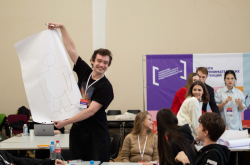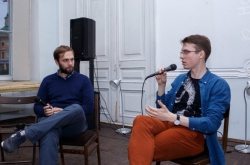Who’s currently working on the “Special Video Analytics” project?
Our team unites experts in several areas. The employees of ITMO University Computer Technologies Laboratory are responsible for scientific developments in the field of machine learning and solving problems that require a powerful scientific background.
We also have experts in the field of industrial automation. For a long time, we have been developing a charging system for toll roads, where we went through the full project cycle from designing the architecture to implementation. So we’ve gained significant experience in the development and implementation of a hardware complex that operates 24 hours a day, seven days a week.
How does the system work?
When a vehicle approaches a barrier or a fence, it triggers several stages of video analysis. Each stage includes an analyzer that performs a specific function. For example, if it identifies an object in front of it as a car, it will then identify its license plate. If a license plate is mudded and can’t be read, the system will analyze the make, model and other characteristics of the vehicle. If it’s an emergency vehicle, it will let it in immediately. The analyzers work in different sequences depending on the results.
ITMO students are involved in the analyzers work. Aleksei Kohanov is working on a detector that identifies emergency vehicles. Roman Lebedev is “writing” the color and license plate detector. Natalia Khanzhina organized the process of analyzers development, and Aleksandr Leutin, who recently joined our team, brought in Linux development skills.
How did you come up with the idea to develop a system that makes decisions based on video analysis?

We came up with it a while ago. I’ve known Andrey Filchenkov, head of the machine learning group at the “Computer Technologies” international lab, since we met at a Math club even before college. We worked with Andrey Yemelyanov on toll roads. At some point, we realized that we could work together and come up with a proprietary product.
We all worked with video so it was natural to focus on video analytics. The project started in July 2017. The original idea was to make a system that only grants access to restricted areas emergency vehicles. It took us a while to find the right business model. We’re currently working with restricted areas adjacent to homes.
How’s your system different from others?
We went through several business accelerators, including ITMO University’s Future Technologies. As a rule, if there’s a cool idea and there are no competitors, then, most likely, the idea is not that cool - in that case either there is no market, or there is a technological barrier impossible to overcome. Since the creation of the project, we have studied competitors and continue to do so today. They include the systems that only analyze license plates, and those that work with access cards, which are the most popular type at the moment.
Our main competitive advantage is that when using our system, it’s impossible to use someone else’s keychain or card, which means that parking places won’t be taken up by unauthorized vehicles.

How does the system make decisions?
The video camera transfers the video feed to the core of the system, where it is processed and analyzed. The frame passes through several processing steps. First, the segmentation of the image takes place - at this stage the system detects the car before a barrier or gate. In the absence of the car, the frame does not go through further processing steps. If the system recognizes the car, then it determines if this is an emergency vehicle, in which case the barrier opens automatically.
The next step is the identification of the license plate in the database. Then it checks other parameters, including body type, color and size, against the database and makes a decision to grant or deny access. If access is granted, it takes a photo of the vehicle entering. This algorithm works both for entry and exit .
You didn’t mention money as one of the implementation issues. Do I understand it correctly changing from the keychain system is not very expensive?
The system is free to the housing management company. The installation and maintenance are covered by monthly fees charged to the residents.
What are your next implementation stages?
We’re planning to release a system that will allow residents to manage the data – access information about coming and going as well as granting guest access through personal profiles or a mobile app. Customers of large property management companies often already have personal profiles where they pay fees and other bills, so we’re thinking about integrating our system with that.
Are you planning to expand your reach?
Right now we’re working with residential areas but in the future we’re planning to work with business centers, manufacturing plants and other secure facilities. We’re also already offering a solution for parking garages that uses the same principles.





